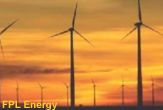Windmills to Change Local and Global Climates

The local morning forecast will be hot, dry, and breezy, and the global forecast could change too if we rely more on large wind farms for electricity, new research shows.
When power companies started installing towering arrays of white wind turbines as a clean, efficient energy alternative to oil and coal, critics pointed to the farms as noisy, unattractive, and fatal to passing birds. Many of these concerns were since addressed, but questions still remained about local and global weather impacts.
Wind power currently supplies about 0.1 percent of the world's electricity demand, according to analysts. America's current wind energy production each year is the energy equivalent of 6.4 million barrels of oil, according to the Department of Interior.
Wind energy output is growing by about 30 percent a year globally.
To answer the global question, David Keith of the University of Calgary and his colleagues estimated the drag that wind farms hypothetically expanded to cover 10 percent of the Earth's land surface could have on the planet's circulating atmosphere. The result showed global cooling in polar regions above 60 degrees North latitude and global warming in temperate regions such as North America at about 30 degrees North latitude.
"The message here is climate change, but that doesn't equal global warming," Keith said. "It's possible this would have benefits," by working against the atmospheric effects of fossil fuel consumption on global climate, he said.
The results were released yesterday and published in the Proceedings of the National Academy of Sciences.
Get the world’s most fascinating discoveries delivered straight to your inbox.
Local effects
Somnath Baidya Roy of Princeton University headed up a related project that studied the impact of simulated, extensive wind farms on local weather and found they could cause a drying and warming effect in the morning when somewhat inefficient turbines end up pushing warm air across moist and cool overnight soil.
Local wind speed would also increase slightly, the experiment showed.
Baidya Roy and his colleagues figured the meteorological costs of a simulated 60-mile-square wind farm by running a mathematical model of a climate system in Oklahoma on a computer. The local impact study was published recently in the Journal of Geophysical Research.
"People treat renewable energy as if it's a free lunch. That is not true," Baidya Roy said. "You always have to pay a price for any consumption. We have to look at the costs and make a choice."
So far, a number of energy companies, especially in the United States and Europe, have made the choice without knowing much about small-scale and large-scale climate impacts. Minor wind farms have been installed along mountain ridges and coastal areas. The best U.S. wind at the optimum distance from urban centers occurs in the Great Plains where larger farms are cropping up.
The culprit in local climate impacts is the turbulent air left in the wake of each turbine's rotors. This artificially energized air stirs up horizontal layers of air near the surface more than normal, leading to more vertical mixing of the atmosphere.
Engineers could reduce the turbulence by designing rotors and farms differently so they produce less wake, possibly by turning rotors up to the sky like helicopter blades or a ceiling fan, Baidya Roy says. To reduce the global climate effects, engineers could install wind farms in ways that their effects counteract one another globally, Keith says.
Or designers could take advantage of hills and dales to tailor the interaction of turbines with the atmosphere.
How serious?
Unaddressed, the severity of the local weather impact induced by large wind farms would fall somewhere between the environmental costs of deforestation and global warming, Baidya Roy said. But people should take these findings in context.
"When I look at these numbers, I think large wind farms still seem to me to be a better choice than air pollution and global warming that you get from coal-powered and oil-powered plants," Baidya Roy said. "When you take all these costs and benefits into account, it's a no-brainer."
Keith agrees. At any given moment, the Earth's population currently is sucking an extraordinary amount of energy - at a rate of 10 terawatts (that's equivalent to the power generated by 800 Hoover dams).
"Humanity is pushing the limits of the world's capacity to sustain us," Keith says.
"We have to stop emitting carbon dioxide (a product of burning oil, coal, or gas) or we'll mess up the climate, but any of the alternatives -- be it nuclear energy, fossil fuels with carbon sequestration, or wind power -- will also have environmental risks and will create other side effects. That is a fact of being as large and power-hungry civilization."
How Wind Makes Power
Turbines capture the wind's energy with propeller-like blades that typically sit 100 feet (30 meters) high where winds are stronger and less turbulent.
1. A pocket of low-pressure air forms on the downwind side of each of two or three blades.
2. The low-pressure air pocket then pulls the blade toward it, causing the rotor to turn.
3. The force of the lift is actually much stronger than the wind's force against the front side of the blade, which is called drag.
4. The combination of lift and drag causes the rotor to spin like a propeller, and the turning shaft spins a generator to make electricity.
SOURCE: FPL Energy; DOI
Robin Lloyd was a senior editor at Space.com and Live Science from 2007 to 2009. She holds a B.A. degree in sociology from Smith College and a Ph.D. and M.A. degree in sociology from the University of California at Santa Barbara. She is currently a freelance science writer based in New York City and a contributing editor at Scientific American, as well as an adjunct professor at New York University's Science, Health and Environmental Reporting Program.




